
Two or three dandelions in your lawn are lovely spots of color. A few dozens signal a weed invasion, and you must do something about it fast. There’s more than one way to get rid of weeds in your grass. You can use the traditional hand-pulling method, prepare homemade solutions, or choose a more aggressive commercial herbicide.
We’re discussing all your best options right here. Let’s see how you can get rid of weeds in your lawn DIY and when it’s time for professionals to step in.
- Steps to Get Rid of Weeds in the Grass
- Identify the Weeds First
- How to Manually Remove Weeds If There Are Just a Few
- Try Commercial Organic Herbicides
- How to Make a DIY Organic Weed Killer
- How to Use Synthetic Herbicides
- Apply Mulch on Surrounding Areas
- How to Prevent Weeds From Growing in the First Place
- FAQ About Weed Control in Grass
Steps to Get Rid of Weeds in the Grass
Before we get into the weeds, as it were, here are the basic steps to take to get rid of weeds in your grass:
- Identify the weeds on your lawn to choose the right product. Not all weed removal methods work for all types of weeds. If you’re unsure of the plants you’re trying to classify, take them to your local County Extension Service for identification or hire a lawn care professional for help.
- Choose a proper herbicide that will kill the type of weed in your lawn without harming your grass type (learn more about how to find these products below). Always try organic weed killers first, since they’re better for your soil and the environment, and only graduate to synthetic herbicides for severe weed problems.
- Wait for a day when the temperature outside is between 45 and 90 degrees, without strong wind, and with little to no chance of rain. If using a commercial product, read the product instructions carefully and use the solution as intended.
- Spread the herbicide, avoiding your grass as much as possible. Most products are non-selective and may harm or kill your grass along with the weeds. Instead of applying herbicide to your entire lawn, apply it only in the specific spots where weeds are present.
- Treat all weeds in and around the lawn to keep them from reseeding and coming back.
- Watch for the return of weeds and as soon as you see one, hand-pull it or spot-spray it with an organic or synthetic herbicide. Don’t let the problem get out of hand again. Prevention is always more effective than mitigation!
In the rest of this article, we’ll go in-depth into each of these steps to help you identify your weeds, choose the right weed removal method for your lawn, and apply your chosen method as efficiently as possible. In the battle against lawn weeds, knowledge and preparation are your greatest weapons.
Identify the Weeds First

The first step to controlling weeds is figuring out what type of weed you’re dealing with.
Annual weeds are the most common. They sprout, grow, flower, spread seeds, and die in less than 12 months. They are the easiest type to get rid of due to to their shallow roots. You just have to learn their life cycle, and you can prevent or treat them effectively. Some annual weeds show up in summer, and some in winter:
- Winter annual weeds (i.e. chickweed, bluegrass, henbit) green up in autumn, grow and flower during winter months, and die back in the spring. They are most vulnerable in late summer and fall when seeds prepare to germinate, and young seedlings appear. Apply pre-emergent herbicides in early fall to prevent them and post-emergent herbicides in late fall or winter to kill fully grown weeds.
- Summer annual weeds (i.e. crabgrass, goosegrass, ragweed) sprout in the spring, grow and flower during summer and fall, and die in the winter (crabgrass, goosegrass). Late winter and early spring is their vulnerable period. Apply pre-emergents in early spring to prevent them and post-emergents in summer to kill fully grown weeds.
Biennial weeds need two growing seasons to reach maturity and spread seeds. They live for two years instead of just one. A few examples are the wild carrot and common burdock. Get rid of biennial weeds by mowing them down or hand-pulling them as soon as you see them. Don’t give them a chance to flower and reproduce. You’ll have two seasons to spot them before they mature!
Perennial weeds are the most resilient, and they can live for over three years. They develop extensive roots beneath the soil. Perennial weeds are spread by seed but also by bulbs, stolons, and rhizomes and are harder to kill. They might appear to die back, only to come back next season. Two common examples are dandelions and thistles. The only way to stop perennial weeds from coming back is to kill the plant completely, either by removing the entire root system or poisoning the plant with herbicides.
It’s also helpful to distinguish between broadleaf, grassy, and grass-like types of weeds since they react differently to weed control methods:
- Broadleaf weeds emerge from the seed with two leaves. Leaf veins are net-like, and their stems are often branched. Dandelions, daisies, clover, ground ivy, oxalis, chickweed, dollar weed, henbit, thistle, and plantain are the most common.
- Grassy weeds have only one seed leaf and long, narrow blades with parallel veins, resembling grass. Crabgrass, foxtail, quackgrass, and annual bluegrass are widespread grassy weeds.
- Grass-like weeds or sedges have triangular stems with smooth and shiny leaves. The most common are wild onion, nutsedge, and wild garlic.
Some herbicides work only on broadleaf weeds, others only on grasses and sedges. So, pay attention to product labels when purchasing commercial herbicides.
Manually Remove Weeds if There Are Just a Few
If you spot a few young weeds on your lawn, don’t ignore them. It’s the perfect moment to solve the problem. You can remove the weeds by hand or using hand weeders, scuffle hoes, or flame weeders. Manually removing weeds is the best way to get rid of weeds without harming your grass.
Hand-Pull the Weeds
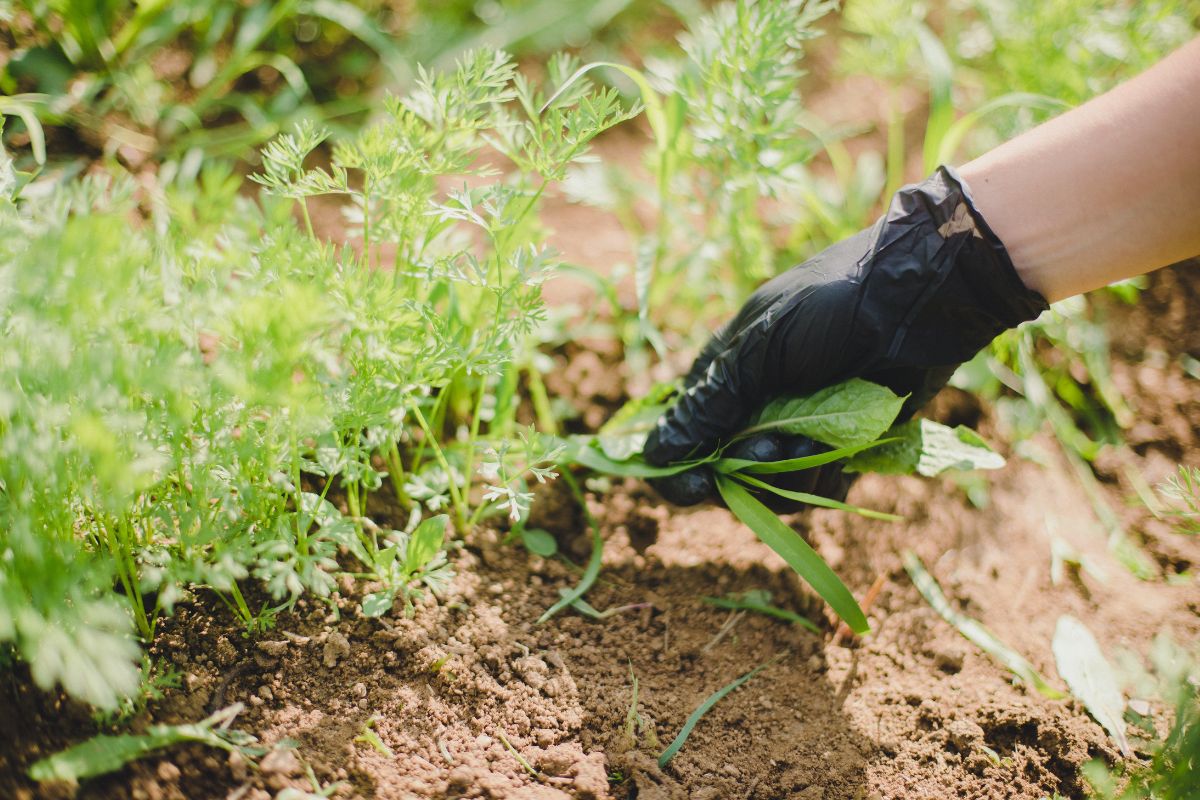
The best moment to pull out weeds is when they are still young and have short roots. To make weed hand-pulling easier, soak the soil the night before. Wet soil is loose and soft, and weeds are easier to pull out with their roots.
Wear thick gloves when you’re hand-weeding. Some weeds have thorns, and grassy weed blades can cut the skin if sliding on it too fast. Use a wide-blade screwdriver or a dandelion fork to pull out the roots. Here’s how:
- Pick up as much of the weed’s stems and leaves as you can in your hand.
- Stick the screwdriver into the soil with the other hand near the root area.
- Move the screwdriver around to loosen the dirt and roots while pulling the weed.
Poke around a larger area around perennial weeds to remove stolons, rhizomes, and as much of the vegetative system as possible. If you don’t remove the root system completely, the weed can grow back.
Use a Hand Weeder
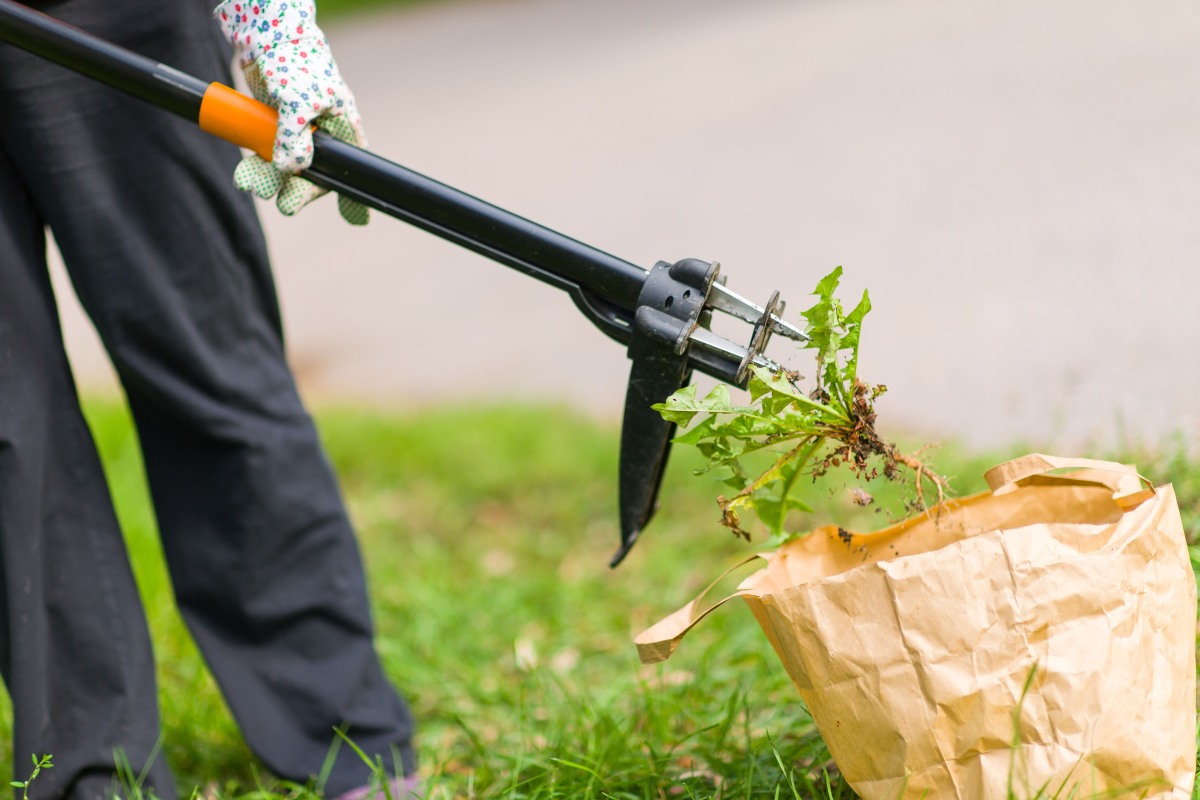
Hand weeders make it easier and safer to pull out weeds and roots. They have different shapes, but the most common type has a blade with a forked tip. Here’s how to use such a tool:
- Poke the forked prong into the ground near the weed roots.
- Push the prongs into the ground to get them as deep as possible into the soil.
- Use the handle like a lever and push down towards the soil to remove the entire plant.
- Pick up the weed with the other hand and pull it out.
- Repeat with the next weed.
Work With a Scuffle Hoe to Cut Weed Roots

With only one move, a scuffle hoe helps you slash the roots under a weed and pull it out. This tool consists of a 5-foot-long handle with a trapezoidal, stirrup-shaped metal blade. To use a scuffle hoe for weed removal:
- Drag the blade through the soil under the weed.
- Push to take it out on the other side of the weed, going through the weed’s roots.
Since roots often remain in the ground, this method only temporarily affects perennial weeds.
Use a Flame Weeder to Burn Weeds on Walkways

A flame weeder is a wand connected to a propane tank that throws flames you can direct to burn weeds. It’s most effective for weeds growing in gravel, cracks in walkways, driveways, etc. You might accidentally burn the grass if you use a flame weeder on the lawn.
The fire doesn’t burn the roots, so it’s mostly a quick fix for annual weeds rather than a long-term solution for perennial weeds.
Try Commercial Organic Herbicides

If your weed problem is past the point of hand-pulling, turn to organic herbicides next. Organic herbicides are less harmful to your turfgrass, the soil, its microorganisms, and beneficial insects like bees and butterflies than synthetic chemicals.
The downside is that they sometimes require more applications and time to get results.
Most organic herbicides on the market use acetic acid (vinegar) or corn gluten as an active ingredient. Let’s see how these substances work and how to use them effectively.
Corn Gluten
A popular fertilizer, corn gluten meal is about 10% nitrogen and has the secondary effect of killing seedlings’ roots due to its peptide content.
When applied to the soil and wetted in with about ¼-inch of water, this granular product releases peptides that starve seedlings’ roots of water. It works only on seedlings and when the application is followed by a dry spell of at least one or two days.
Apply products with corn gluten meal in late March to mid-April for good results. If you want to seed new grass, wait 4 to 6 weeks after applying the herbicide, or it will kill the new grass seedlings, too.
Use on: seedlings of crabgrass, pigweed, and dandelion
Where to buy corn gluten meal products:
- Amazon – Jonathan Green 11591 Corn Gluten Lawn Fertilizer
- Home Depot – Purely Organic Weed and Feed Lawn Food
- Walmart – Old Cobblers Farm Corn Gluten All-Natural Weed Prevention
- Lowe’s – Preen Natural Vegetable Garden Weed Preventer
Acetic Acid (Vinegar)
Kitchen vinegar is 5% acetic acid diluted in water. Acetic acid herbicides have higher concentrations of up to 20%. They kill the plants by desiccation, drying them out from the inside. Acetic acid breaks down cell walls, and plant fluids leak out. Treated weeds turn discolored and brown, then black and mushy.
Treat weeds with this type of solution by spot-spraying. Cover each weed thoroughly with liquid but pay attention not to get any on the surrounding grass. Vinegar-based solutions are non-selective weed control products. They attack all the plants they touch, including turfgrass.
They are also a contact “top-killer” type of herbicide. Acetic acid kills only what it touches and doesn’t move through the plant. Roots are not damaged. It’s effective on annual weeds and young plants but less so on perennial weeds and plants with deep roots.
Use on young, growing annual weeds and broadleaf weeds.
Warning! Acetic acid from herbicides can irritate or burn the skin, eyes, and respiratory tract.
Where to buy weed control products with acetic acid:
- Amazon – Green Gobbler 20% Vinegar Weed & Grass Killer
- Home Depot – Green Gobbler 5 Gal. 20% Vinegar Weed Killer
- Walmart – Harris 30% Pure Vinegar, Extra Strength Formula Weed Killer
- Lowe’s – Uncle Steve’s Weed Killer Trigger Spray
How to Make a DIY Organic Weed Killer
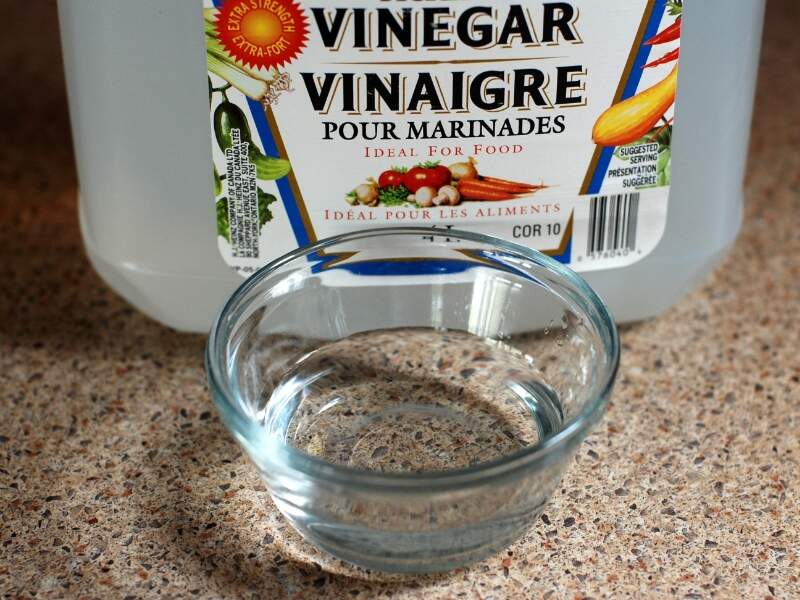
With bunches of weeds in your lawn, applying a homemade weed killer can be easier than pulling out the weeds manually and cheaper than buying commercial herbicides. Most lawn owners have the ingredients at home, and preparing the formula takes only a few minutes or less.
Warning! DIY herbicides are not 100% safe for your grass and soil. They can also damage your lawn if misused. Do your best to apply only on the weed’s surface. Avoid spraying on grass or soil.
Let’s look at three simple but effective DIY weed killers you can make right now.
White Vinegar and Soap
You can prepare an effective vinegar weed killer at home using castile soap and white vinegar with 5% to 20% concentration. The higher, the better.
Recipe and application:
- Add 1 cup of castile soap and 1 gallon of vinegar into a bucket.
- Mix thoroughly.
- Pour the solution into a plastic spray bottle.
- Wear garden gloves (the solution can irritate your skin).
- Treat the lawn on a sunny, dry day with no wind.
- Apply the solution to coat the weed leaves and stems thoroughly.
Precautions: Avoid spraying the soil, the grass, or plants nearby that are not weeds. The solution can damage them.
Baking Soda

Ordinary baking soda draws water from the leaf cells and dries the foliage. It’s also easy to use and effective without adding anything else. Here’s how to use it.
Recipe and application:
- Spread a fine mist of water with your hose across the weeded areas. You need the leaves wet so the baking soda can stick long enough to act.
- Measure one spoonful of baking soda.
- Spread it evenly across one weed’s leaves.
- Repeat with all the weeds you want to kill.
If you’re treating weeds on driveways and walkways or in gravel, spread the baking soda generously over the weeds.
Warning! Baking soda is not a selective herbicide and will damage your grass if you get any on its blades.
Boiling Water
You can also use simple boiling water to kill the weeds. Here’s what you need and how to use it.
Recipe and application:
- Put water into a kettle and heat until boiling.
- Pour directly on the weed doing your best to get all the leaves and stems while avoiding surrounding grass or plants you want to keep.
- Repeat the process again after 7 to 10 days.
Warning! Be careful not to get boiling water on your skin.
How to Use Synthetic Herbicides
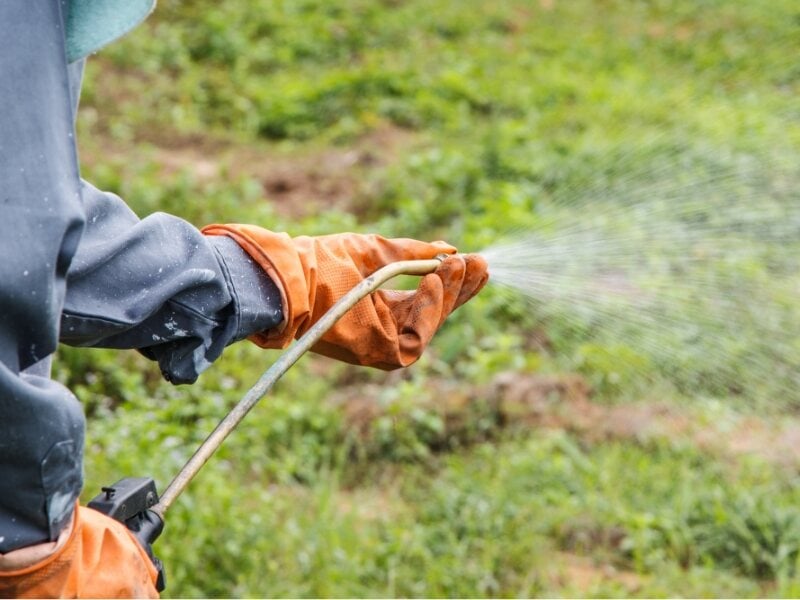
If you’ve tried all the organic methods and nothing seems to work, you can turn to synthetic herbicides as a last resort. They’ll almost definitely be effective at getting rid of your weeds, but they may harm your grass and helpful pollinators in the process.
Synthetic herbicides are very effective but can also pollute the soil and local bodies of water if used incorrectly. There are two main categories of herbicides: pre-emergent herbicides and post-emergent herbicides.
Pre-Emergent Herbicides
A good way to prevent weeds is to nip them in the bud by applying a good pre-emergent herbicide before the weed seeds germinate. These products prevent seedlings from establishing roots and shoots. Apply in:
- Winter to early spring (January to March) for warm-season weeds, before soil temperatures exceed 55 degrees.
- Late summer and fall (August to November) for winter weeds, when the soil temperatures reach 70 degrees and continue to drop.
The exact time is a matter of location and climate. Typically, more than one application is recommended since the solution is active for only 4 to 8 weeks from the time of application.
Post-Emergent Herbicides
Consider using a post-emergent herbicide when the weeds are grown and in large numbers on your lawn. Let’s see the most common types and when to use them.
- Contact herbicides kill only what they touch and are excellent for annual weeds. You must apply multiple times to get results on perennial lawn weeds.
- Systemic herbicides enter the plant through leaves and stems and move throughout it, killing it altogether. These are the go-to products for perennial weeds and can deal with extensive networks of stolons and rhizomes.
- Selective herbicides are made to kill only specific types of weeds and grass and have minimal effect on your turfgrass (if chosen correctly).
- Non-selective herbicides kill everything, and you need to spot-spray them only on the weeds, avoiding contact with the grass.
See our top picks for the best post-emergent herbicides to help your shopping process go smoothly. Choose the right post-emergent herbicide formula for the type of weed but also for the grass type you have on your lawn. Some grass types are more sensitive to herbicides than others.
Always use the proper tool for the coverage you need. Go for a small pressure sprayer for spot applications. Use a tank sprayer for a regular home lawn and a dial sprayer for a large yard.
Professional-Grade Herbicides
Sometimes, the herbicides you can buy at the store aren’t enough to kill stubborn weeds. Don’t lose hope. There are extremely potent weed-killing chemicals that are available only to licensed professionals. If DIY applications of herbicides aren’t getting rid of the weeds in your lawn, it may be time to call in a weed control pro for help.
Apply Mulch on Surrounding Areas

Applying a 2- to 3-inch thick mulch layer is a practical, natural way to prevent weeds from emerging on flower beds and vegetable plots. Since it prevents sunlight from reaching the soil surface, even if weed seeds germinate, the seedlings won’t be able to conduct photosynthesis and grow.
You can’t use this strategy on your lawn, but it protects the grass by preventing weeds from growing in your garden or landscape beds and sending seeds into the grass.
Use organic mulch, such as bark nuggets, grass clippings, straw, and shredded bark to benefit from the nutrients they add to the soil. You can buy mulch at a garden supply store and spread it yourself or hire a landscaping company. Professional mulching services cost around $37 – $113 per cubic yard of mulch needed.
Another good idea is to cover weeded areas with landscape fabric or plant ground covers to crowd out the weeds and limit their spread.
How to Prevent Weeds From Growing in the First Place

A green, healthy lawn is the best strategy to control weeds. If the grass is tall and dense, weed seeds don’t get enough sun to emerge, and seedlings don’t have enough space, nutrients, and water to grow.
To keep a weed-proof lawn, follow these essential rules of lawn care:
Mow the Grass to the Right Height

When you mow the grass too short, you expose the soil to sunlight and warmth and help weed seeds emerge. Shorter grass is also more stress-prone and can lead to bare patches where weeds thrive. See the recommended mowing height for the most popular grasses in our detailed mowing height guide.
It’s also important to mow correctly by following these principles:
- Cut no more than ⅓ of the grass’s height at once.
- Keep your lawn mower blades sharp.
- Vary your mowing pattern to avoid soil compaction and grass damage from foot traffic.
Don’t leave the grass clippings on your lawn if you have weed problems. You risk helping them spread. Also, avoid adding weedy grass clippings to your compost pile. The weed seeds remain dormant until you spread compost on the soil and then start to germinate.
Apply Turf Fertilizer During the Growing Season
Apply nitrogen-rich fertilizer only during your grass type’s growing season so the turfgrass may use nutrients effectively. Otherwise, the excess fertilizer in the soil will feed emerging weeds.
Use slow-release fertilizer and check the amounts recommended for your type of grass. Apply the fertilizer with a spreader to ensure uniform coverage.
Water Deeply and Infrequently

When you water thoroughly and less often, you stimulate the turfgrass to grow deep, extensive root systems.
Deep roots strengthen the grass, making it less vulnerable to drought, heat, and diseases. With healthy grass, weeds stand little chance of taking over large areas in your lawn.
Be careful not to overwater, as weeds will soak up the excess water in the soil and use it to take over your grass.
Check the Soil
Weeds thriving in your lawn are often a sign of soil problems. It can be the soil pH or unbalanced nutrients. Test the soil to discover what is wrong and how to treat it.
Take some soil samples around the yard (here’s a helpful guide on collecting soil samples) and send them to your local Extension Service.
Soil tests cost about $10 to $20. Results come back in a few days to a few weeks with a detailed report that tells you:
- Soil pH and how to balance it if the soil is too acidic or alkaline.
- If there are nutrient deficiencies and how to correct them.
- The soil texture and how well it absorbs water and nutrients.
Aerate Your Lawn Every Fall

Weeds thrive in compacted, dry soil, and turfgrass grows better in the loosened, well-watered ground. Lawn aeration is an excellent way to loosen the soil and make your turf less welcoming to weeds and better for the grass. Core aerate every fall to keep a healthy, green, weed-free lawn.
Overseed Periodically
Grass lives for 7 to 8 years. Some lawns will die even sooner due to heat or drought stress. Don’t let bare patches or thin areas into your lawn. They are opportunities for weeds to emerge and thrive. Overseed new grass in spring and fall to keep a dense, healthy turf.
FAQ About Weed Control in Grass
To kill only the weeds, look for a selective herbicide. The most common are products with 2,4-D as their active ingredient.
Shop 2,4-D weed control products:
● Amazon – Southern Ag Amine 2,4-D WEED KILLER
● Walmart – V.P.G. Hi-Yield 2,4-D Selective Weed Killer
A good systemic herbicide can help you remove annual and perennial weeds with the best chances of not regenerating. Hand-pulling also works, but only if you remove the plant’s entire root system.
Vinegar, baking soda, and boiling water are three natural home remedies that you can use to kill the weeds in the grass.
If you have just a few weeds in your lawn, you can pull them out by hand or use a hand weeder (a puller or a cutter) to help you remove them easier. Water the lawn to loosen the soil before doing this if it hasn’t rained in the past 24 hours.
In our opinion, the best weed killers that are safe to use on lawns are Ortho WeedClear Lawn Weed Killer for Northern Lawns and Ortho WeedClear Lawn Weed Killer for Southern Lawns. Learn why we love these products so much and find other recommendations in our list of the best weed killers on the market right now.
You can also check out our recommendations for the best weed killers for flower beds to find herbicides that are better suited to gardens and landscape beds.
Weeds Still a Problem? Hire a Lawn Care Pro
Stubborn weeds disturb your lawn’s manicured look and steal precious nutrients and water from your grass. Don’t give weeds too much room to breathe! Act now! Keep your lawn healthy, green, and dense, and use the correct herbicide to kill the invaders.
Not enough time for weeding? We’ve got you covered. Hire a LawnStarter pro near you to get rid of weeds for you, and enjoy a weed-free lawn in no time!
Main Photo Credit: DmitryTkachev / Canva Pro / License
LawnStarter participates in the Amazon Services LLC Associates Program and other affiliate advertising programs. LawnStarter may earn revenue from products mentioned in this article.


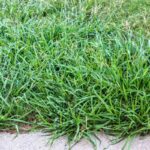

![8 Best Pre-Emergent Herbicides for Lawns [Reviews]](https://www.lawnstarter.com/blog/wp-content/uploads/2021/11/Best-Pre-Emergent-Herbicide-150x150.jpg)
